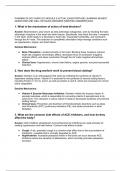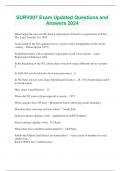PHARMACOLOGY NURS 251 MODULE 5 ACTUAL EXAM PORTAGE LEARNING NEWEST
QUESTIONS AND WELL DETAILED ANSWERS [VERIFIED ANSWERS] 2024
1. What is the mechanism of action of beta-blockers?
Answer: Beta-blockers, also known as beta-adrenergic antagonists, work by blocking the beta-
adrenergic receptors in the heart and other tissues. Specifically, they block the beta-1 receptors
in the heart, which leads to a decrease in heart rate, myocardial contractility, and conduction
through the AV node. This reduction in sympathetic stimulation helps manage conditions such
as hypertension, angina, and heart failure.
Detailed Mechanism:
● Beta-1 Receptors: Located primarily in the heart. Blocking these receptors reduces
heart rate (negative chronotropic effect), decreases force of contraction (negative
inotropic effect), and slows conduction through the AV node (negative dromotropic
effect).
● Clinical Uses: Hypertension, chronic heart failure, angina pectoris, and post-myocardial
infarction.
2. How does the drug warfarin work to prevent blood clotting?
Answer: Warfarin is an anticoagulant that works by inhibiting the synthesis of vitamin K-
dependent clotting factors. Vitamin K is essential for the synthesis of several clotting factors,
including Factors II, VII, IX, and X, as well as proteins C and S, which are necessary for normal
blood coagulation.
Detailed Mechanism:
● Vitamin K Epoxide Reductase Inhibition: Warfarin inhibits the enzyme vitamin K
epoxide reductase, which is responsible for converting vitamin K epoxide back to its
active form. This reduction in active vitamin K leads to decreased synthesis of functional
clotting factors.
● Clinical Uses: Prevention and treatment of thromboembolic disorders such as deep
vein thrombosis (DVT), pulmonary embolism (PE), and stroke prevention in atrial
fibrillation.
3. What are the common side effects of ACE inhibitors, and how do they
affect the body?
Answer: ACE inhibitors (Angiotensin-Converting Enzyme inhibitors) are used primarily for
treating hypertension and heart failure. Common side effects include:
● Cough: A dry, persistent cough is a common side effect due to the accumulation of
bradykinin, a peptide that is normally degraded by ACE.
● Hyperkalemia: Increased potassium levels in the blood can occur because ACE
inhibitors reduce the secretion of aldosterone, which normally promotes potassium
excretion.
, ● Hypotension: Especially after the first dose, due to the drop in angiotensin II levels,
which normally help to maintain blood pressure.
● Angioedema: Swelling of deeper layers of the skin, particularly in the face and throat,
which is a rare but serious side effect.
Detailed Mechanism:
● Inhibition of Angiotensin II Production: ACE inhibitors block the conversion of
angiotensin I to angiotensin II, a potent vasoconstrictor. This leads to vasodilation,
decreased blood pressure, and reduced workload on the heart.
4. Describe the difference between Type I and Type II diabetes in terms of
pharmacological management.
Answer:
● Type I Diabetes: This is an autoimmune condition where the pancreas produces little to
no insulin. Management primarily involves insulin therapy, as patients are unable to
produce insulin endogenously.
Pharmacological Management:
○ Insulin Injections: Different types of insulin (rapid-acting, short-acting,
intermediate-acting, long-acting) are used to mimic normal pancreatic function.
○ Insulin Pumps: Provide continuous insulin infusion and help with glucose
control.
● Type II Diabetes: This condition is characterized by insulin resistance and eventually a
relative insulin deficiency. Management often begins with lifestyle changes and oral
medications, with insulin therapy added as needed.
Pharmacological Management:
○ Oral Hypoglycemics: Includes metformin (which decreases glucose production
in the liver), sulfonylureas (which increase insulin secretion), and others.
○ GLP-1 Agonists and DPP-4 Inhibitors: These medications improve insulin
sensitivity and secretion.
○ Insulin Therapy: May be added if glycemic control is not achieved with oral
medications alone.
5. What is the role of diuretics in managing hypertension, and what are
their common types?
Answer: Diuretics help manage hypertension by promoting the excretion of sodium and water
from the body, which reduces blood volume and consequently lowers blood pressure.
Common Types and Their Roles:
● Thiazide Diuretics: Such as hydrochlorothiazide, are often used as a first-line treatment
for hypertension. They work in the distal convoluted tubule of the nephron to increase
sodium and water excretion.
● Loop Diuretics: Such as furosemide, are more potent and act on the ascending loop of
Henle. They are used for more severe cases or when thiazides are insufficient.
, ● Potassium-Sparing Diuretics: Such as spironolactone, help retain potassium while
excreting sodium and water. They are often used in combination with other diuretics to
prevent hypokalemia.
Each type of diuretic has its specific indications, side effects, and potential interactions, which
should be considered in the context of individual patient needs.
6. What are the key differences between opioid and non-opioid analgesics?
Answer: Opioid and non-opioid analgesics are used to manage pain but have different
mechanisms and indications.
● Opioid Analgesics:
○ Mechanism: Act on opioid receptors in the central nervous system (CNS) to alter
the perception and response to pain. They include drugs like morphine,
oxycodone, and fentanyl.
○ Effects: Provide effective pain relief, especially for moderate to severe pain.
They can also produce euphoria, leading to potential misuse or addiction.
○ Side Effects: Common side effects include nausea, constipation, sedation,
respiratory depression, and potential for dependence or addiction.
○ Indications: Used for acute pain (e.g., postoperative pain) or chronic pain
conditions that do not respond to non-opioid analgesics.
● Non-Opioid Analgesics:
○ Mechanism: Work through different pathways. For example, NSAIDs (Non-
Steroidal Anti-Inflammatory Drugs) inhibit cyclooxygenase (COX) enzymes,
reducing prostaglandin production and inflammation. Acetaminophen’s exact
mechanism is not fully understood but involves central inhibition of prostaglandin
synthesis.
○ Effects: Typically used for mild to moderate pain and inflammation. They
generally have a lower potential for addiction compared to opioids.
○ Side Effects: NSAIDs can cause gastrointestinal issues, renal impairment, and
cardiovascular risks. Acetaminophen can cause liver toxicity in high doses.
○ Indications: Used for conditions like osteoarthritis, headaches, and mild to
moderate pain without significant inflammation.
7. How do calcium channel blockers work and what conditions are they
used to treat?
Answer: Calcium channel blockers (CCBs) are a class of medications that block calcium entry
into cells through voltage-gated calcium channels, primarily in the heart and blood vessels.
Mechanism of Action:
● Vascular Smooth Muscle: By blocking calcium channels, CCBs cause relaxation of
vascular smooth muscle, leading to vasodilation and reduced blood pressure.
● Heart: They also decrease cardiac contractility and conduction through the AV node,
which can help control heart rate.





